The last few Fowl Fridays have been all about the drama in Frodo’s world, but what happened to our turkeys?
Our four turkeys have been at the farm for twelve weeks, and are now 17 weeks old. There have been some significant changes since they arrived at the farm.
There’s no question now that we have three males and one female. During our last turkey update the presumed Jakes (males) appeared to be showing more prominent snood growth than the presumptive Jenny (female). We also had clues from the size of the caruncles as to who might be who. However, we’ve never had turkeys before, so we weren’t completely sure.
Both the snoods and caruncles have become more prominent in the Jakes over the last few weeks though, removing any doubt.
Overall body size has increased substantially in the past few weeks too. The male Bourbon Red/Royal Palm crosses are the largest, and also have the largest snoods. The Bourbon Red/Standard Bronze Jake is somewhat smaller in stature, and his snood not quite so impressive, yet.
The feather coloring has become much richer in both the Royal Palm crosses, and the Standard Bronze crosses.
The male Bourbon Red/Standard Bronze cross is showing some beautiful iridescence in some of his body feathers.
The Jenny of the same cross is now easily distinguished from the Jake as the edges of most of her body feathers have a cream-colored border along the edges, giving her a slightly lighter appearance.
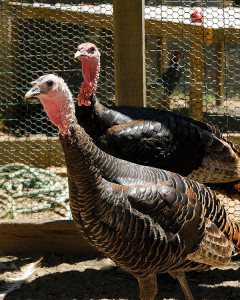
The Bourbon Red/Standard Bronze Jenny (front) has pale body feather margins compared to the Jake (back)
The red-toned Royal Palm crosses, although not apparent when they were younger, are starting to show some dark edging to their body feathers too.
We’ve discovered that overall turkeys are far more suspicious of new things in their environment than chickens.
You’ll notice in the video that they make an interesting series of chirps when confronted with a new treat (off camera) that they don’t recognize. It took an entire day for them to muster enough courage to investigate a simple slice of melon. The chickens would have devoured it in 10 minutes!
We also have experienced the downside to having too many future Toms in the mix. Boys will be boys, and we’ve broken up a couple of fights between the Jakes over the past six weeks. Siegfried, our rooster, has recently taken to crowing in the mornings, and for some reason this seemed to agitate the Jakes. In fact Siegfried’s crowing was at least partially responsible for more than one scuffle between the three Jakes, although the Jakes do now seem to be getting used to their early morning wake-up calls. We suspect part of the problem was that turkeys like the status quo, they don’t like change, or differences in their environment, and having a crowing rooster around is, well, different.
The Jakes seem to be primarily posturing and play fighting thus far. Snoods, and especially wattles, are fair game during a scrum, and it takes quite a while to get them to calm down once a ruckus has ensued! You’ll probably notice the Bronze cross Jake in the video has a couple of minor grazes on his face from a recent skirmish. Ideally we’d have multiple Jennys, not Jakes.
Although there’s only one Jenny at the farm, our brood are too young to be concerned with trying to garner her attention yet. However, we will need to reduce our male quotient before next spring, or the fighting will become more serious.
It’s interesting to note that popular commercial broad-breasted turkeys are usually harvested between 14-18 weeks of age. Our turkeys already fall into the upper end of that age bracket. However, heritage breeds (including heritage crosses) take significantly longer to mature, usually in the realm of 6 months before they are ready for the table. Don’t worry though, we have many more weeks to go before then, and in the meantime we’ll continue to spoil our turkeys rotten, they deserve it.
—————

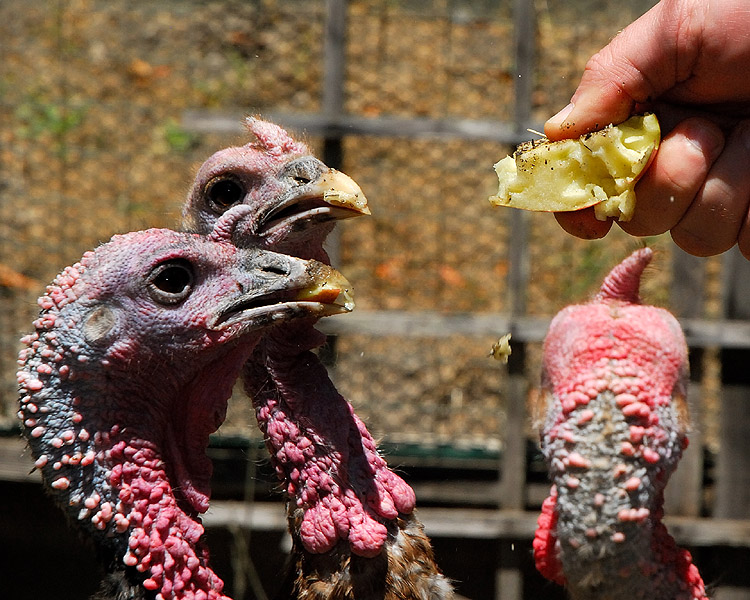
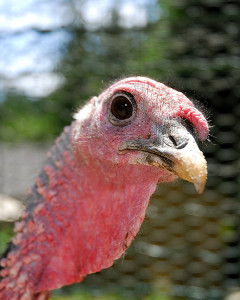

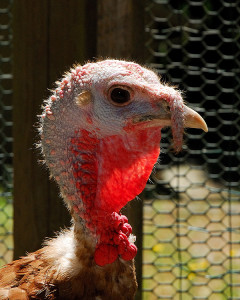
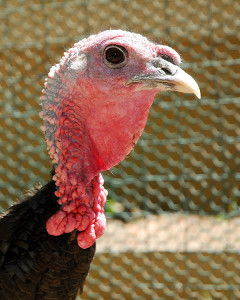
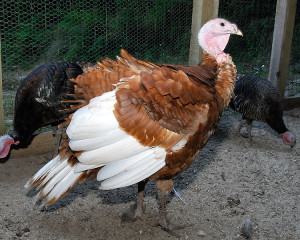
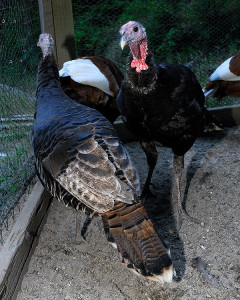
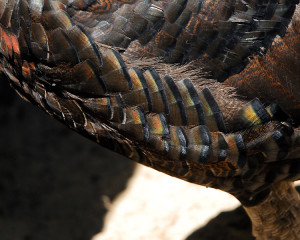
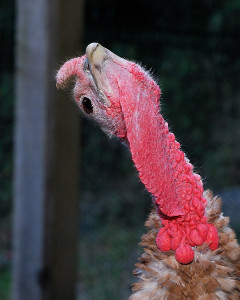
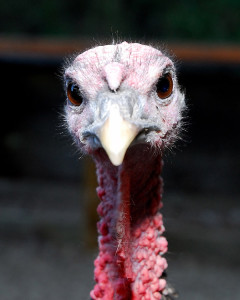
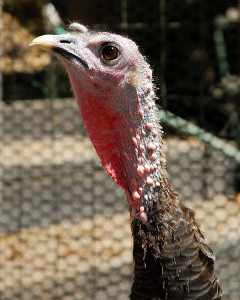
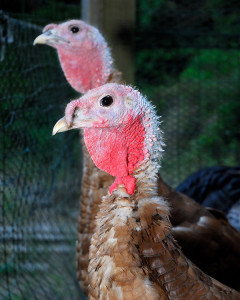
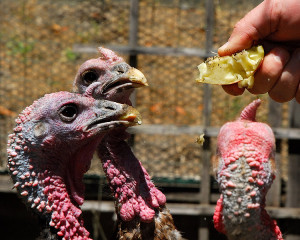







Ok, at the risk of seeming indelicate, I have a question about the snoods on the boys, you know, the “largest ones” and the ones that are, um, somewhat smaller and “not quite so impressive.” It’s not obvious in the pictures, but do their snoods dress to the left or to the right? Or do they just flop around? ;•))
Shorter snoods don’t move about much. The long snoods, as seen in part of the video, tend to follow head-tilt and gravity though 😛
Right.
Wow! The turkeys are getting huge! Wonder why turkeys are more skittish than chickens? Are you going to let the Jenny eventually raise a brood?
Not sure why turkeys are more skittish. They do take longer to ‘grow up’ than chickens. In the wild they’re dependent on their mothers for the first year. If they were with an adult female, I wonder if they’d be less worried about new things in their environment.
Our plan, assuming everyone continues to do well, is to breed the Standard Bronze cross pair together in the spring. We plan to write a ‘turkey color genetics’ post soon which will explain why we’d breed those two, rather than crossing the Royal Palm crosses with the bronze Jenny 🙂
Glad to get an update on the Turkeys this week Clare. They certainly have grown and their plumage is very beautiful but its the iridescent feathers that I always admire either in chickens or turkeys.
I had a chuckle when I saw that photo of the turkey twisting his neck to see what was above him – thats a good one!
Have a lovely weekend Clare and I hope those Jakes get used to hearing that crowing at the break of dawn. I’ll be in the company of peacocks today 🙂 Rosie
Oh, peacocks, how fun! They’re such beautiful birds.
The question isn’t so much whether the turkeys can adjust to Siegfried’s crowing…it’s whether I can! 😛
Do all the animals at Curbstone valley have tremendous characters? Love the posturings of your Jennys and Jakes and the variety of feathers colouration.
Laura
You know, I think they do!
Despite turkeys looking somewhat, prehistoric, at least at the head end, they really are quite pretty birds. They’re also somewhat formidable when they fly over your head. It’s a bit like being buzzed by a pterodactyl! Not that I’m old enough to remember pterodactyls of course 😀
Dear Clare, I do love reading your postings about the goings on at Curbstone Valley but there does always seem to be something resembling a bar fight going on with some of the residents. I have seen films of the Wild West and you seem to be living with it on a daily basis. Is Clint Eastwood visiting soon to sort it all out?!!
It has felt like the wild west around here this year. Last I heard, Clint Eastwood was living just south of here. I wonder if he makes house calls? 😛
Good Morning Clare, Enjoyed your post and video. I love the curiosity of the Jakes and Jennys. I so admire your raising your own food and giving these beautiful creatures a good life. You do seem to have to break up a few fights a day. How funny the roosters ritual stirs them up. Great photos! I love the one stretching his neck! :>)
They really are amazingly curious creatures, and fun to watch!
Raising our own food, beyond vegetables and fruits, is certainly an experience, but we at least have the knowledge of knowing our turkeys have a much better life than most. 🙂
Love the photos! We’re going to be getting turkeys next Spring (I may have already mentioned that). I just have to say it…They are so ugly! But in an endearing way. LOL
My only advice on the turkey front, is don’t get too many, and don’t have them too close to the house. They certainly have significantly more odor than chickens. On the upside, you’ll get a lot of fertilizer for the gardens 😛
Excellent photo journal of the turkey’s rise to adulthood! Really great information… we are tempted to get some turnkeys in the future. We were presented with four year-old broadbreasted male turkeys to slaughter for a neighbor who had no idea what to do with them. She had received them as a surprise from her husband and they were about 40 ponds each, I kid you not. Needless to say, slaughtering the birds was a real adventure but we got it done. The moral of the story is, as you point out in your post, be cognizant of the timeline with these birds… or you will end up with giants!! The broadbreasted birds are so pitiful at a year of age, they can barely do anything, they are so massive and heavy. Your heritage birds are graceful and thrifty, and glossy. Clearly receiving excellent care!! Bravo. Cheers, Bonnie
Oh my! Four years old? Can’t imagine those were very good eating, unless cooked for a very long time. I have a real issue with the mutant breeds we’ve created for the food production industry. Whether it’s broad-breasted turkeys, or Cornish rock-x mutant chickens. I know it maximizes feed conversion, and they’re more economical to raise, but they can’t walk, can’t fly, and can’t breed naturally. At least heritage birds look like they should, and can actually run around and have fun! 🙂
What a fascinating idea to raise your own turkeys. They’re not the world’s most adorable creature, but look like they have plenty of character. Interesting post. Barbara
I’ve never thought that turkeys would love fresh apples!… Their heads remind me of an oystrich!
The pic where the turkey looks suspicious of change made me giggle. Actually, maybe I need to take that and tape it to my desk, along with a note to not be a turkey — since I’ve lately been more than nervous about the upcoming changes in our lives here. 😉 Very cute.
I guess being suspicious of new food items got them where they are today, evolutionarily speaking, but it seems it would have run counter to survival if, when confronted with fresh melon, one turned it down for hours!
I’m so thrilled you plan to breed them, Clare!
If I never get to live on a farm again, I can enjoy your stories, pix and videos. Thank you so much! Curious about one thing. Do the turkeys stay in their cage all the time? If you let them out, how do you keep them from running away or being nabbed by a hawk?
The turkeys have spent most of the time either in the pen, or a portable pen out on grass. We are planning to let them roam in the orchard shortly, but were waiting for their primary feathers to completely grow out before clipping them. These birds can fly phenomenally well, and for their own safety (and so we don’t break county ordinances) we don’t want them flying off. The orchard fence is 7 foot though, so once wing clipped they should be fine. Like the chickens, they’ll range when we can keep one eye on them. Hawks do circle here, often, but even our chickens would be a challenge for them. I’d have to think they’d be hard pressed to catch a turkey (well, except that the turkeys might not be smart enough to run away :P)
Snoods and Caruncles…its a whole new world of vocabulary you are introducing me to! If you need someone to do the dastardly deed near Thanksgiving I can send Shane to you. I don’t think I’d have the minerals to do it!
Clare, your turkeys are the sweetest birds ever! Their eyes are kind and telling of their pleasant personalities. I’m surprised at how big they are already! The feather colors and patterns are so artisic and beautiful! And the fact that they’re so careful…interesting! So many wonderful attributes to these birds! How could anyone not love them?!?!
I love the head on shot of the turkey! It is interesting to read about inborn personality traits in turkeys. Maybe they are skittish because they inherently suspect they are bound for the dinner table!